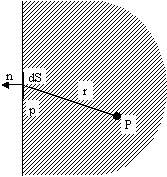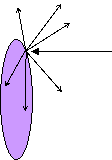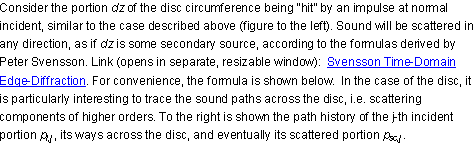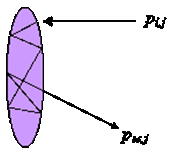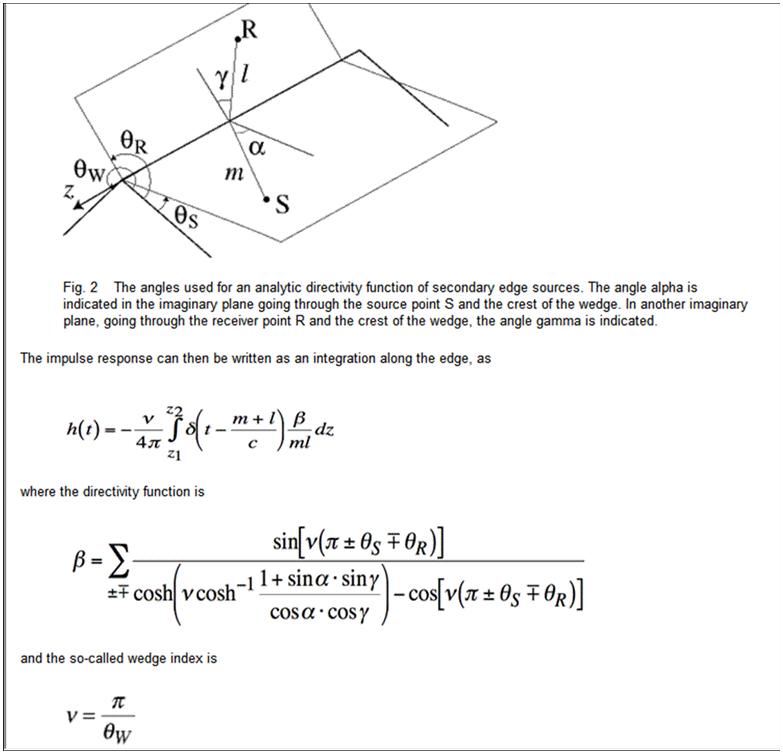
|
Reflecting Disc — equivalent dipole source |

|
Go to www.akutek.info main page Go to article site index page Introduction An interesting special case among sound reflectors is the ideal rigid, infinitely thin, disc of radius a. Piercea (1981), with reference to Lord Rayleigh in 1897, presented an analytical solution for the scattered pressure psc from a disc of radius a in the low-frequency case ka<<1, resulting from an incoming plane wave pressure pi along the x-axis normal to the disc (fig 1). The analytical solution provides verification for physical and mathematical models suggested for prediction of reflections from reflection panels in general and the disc in particular. At the bottom of this page there are several links to some related articles.
|
|
1. Scattered pressure psc from a disc of radius a, resulting from an incoming plane wave pressure pi , with wave number k, along the x-axis normal to the disc, expression by Pierce:
|
|
2. In the far field, at distance r from the disc, in direction θ , the scattered pressure from can be written psc = pi ∙(ka)2/ (4p r) ∙8a/3 ∙ cos θ Pierce identifies the dipole radiation characteristics of the scattered pressure from the disc, in contrast to scattering from a sphere, which would be a combination of a monopole component and a dipole component. |
|
3. According to Kinslerb and Frey, a dipole source can be expressed on the form: pd = rc kq /(4pr) ∙kD∙cosq , where D is the distance between the monopole-pair of source strengths q and –q , respectively, and rc the characteristic impedance of the medium |
|
4. Assuming that the scattered pressure from the disc is equivalent to the radiation from a dipole described in (3), what will the source strength and the distance D of the equivalent source be? Equating the right-hand expressions in (2) and (3) reveals that the source strength must be equal to the volume velocity of the cross-section p a2 of the wave incident on the disc q = p a2 ∙ui = p a2 ∙pi/rc , |
|
5. ...while the dipole-distance must be D = 8a/3p ~ 0.85∙a Note that D is equal to the classical end-correction of a pipe having radius a, and the height of the air-mass associated with the radiation reactance of a circular piston with radius a , oscillating in an infinite baffle.
|
|
6. As noted in the introduction, the above solution (1-2) is valid in the low frequency case ka<<1. A general solution can be derived from the Helmholtz-Kirchhoff Integral Theorem, which expresses the sound pressure in a point P in a volume surrounded by a closed surface S as follows:
where p and Ñ p are the pressure and the pressure-gradient at the closed surface S, and r is the distance from P to the infinitesimal surface element dS with a normal vector n pointing away from P. In the far field low frequency case (kr>>1 and ka<<1), a number of simplifications can be made, since e-ikr/r vary negligibly over the surface of interest.
|
|
7. A different approach towards insight in scattering from a disc would be to study edge-scattering in the time-domain. |
|
|
|
Footnotes a. Pierce, A, ”Acoustics - an introduction to its physical principles and applications” (1981, p427) b. Kinsler and Frey, “Fundamentals of Acoustics” |
|
Relevant akuTEK links: An improved low frequency radiation model for finite sound reflectors (presentation) Frequency Limits of reflector arrays—status report (paper) (poster) Frequency Response of Reflector Arrays Low Frequency Limit of Reflector Arrays (Paper 2006) Low Frequency Limit of Reflector Arrays (Poster 2006) Low Frequency Limits of Reflector Arrays (Paper 2007) Low Frequency Limits of Reflector Arrays (Presentation 2007) Orchestra Canopies—Significant Features (Paper 2006) Orchestra Canopies—Significant Features (presentation) Reflector above the opera orchestra pit Reverberant Space (demo) Sound Transmission Through the Orchestra (paper) Sound Transmission Through the Orchestra (presentation) Stage conditions for orchestral performance (paper) (presentation) The scattering from reflector panels with convex edges
External links: Svensson Time-Domain Edge-Diffraction
Scattering and reflections from flat surface, single panel and arrays, curved surfaces and arrays, overhead canopy design (RPG White Paper)
|
|
|
|
To be continued First published 28.01.2012, latest change 14.12.2012 Go to www.akutek.info main page Go to article site index page |
|
|



